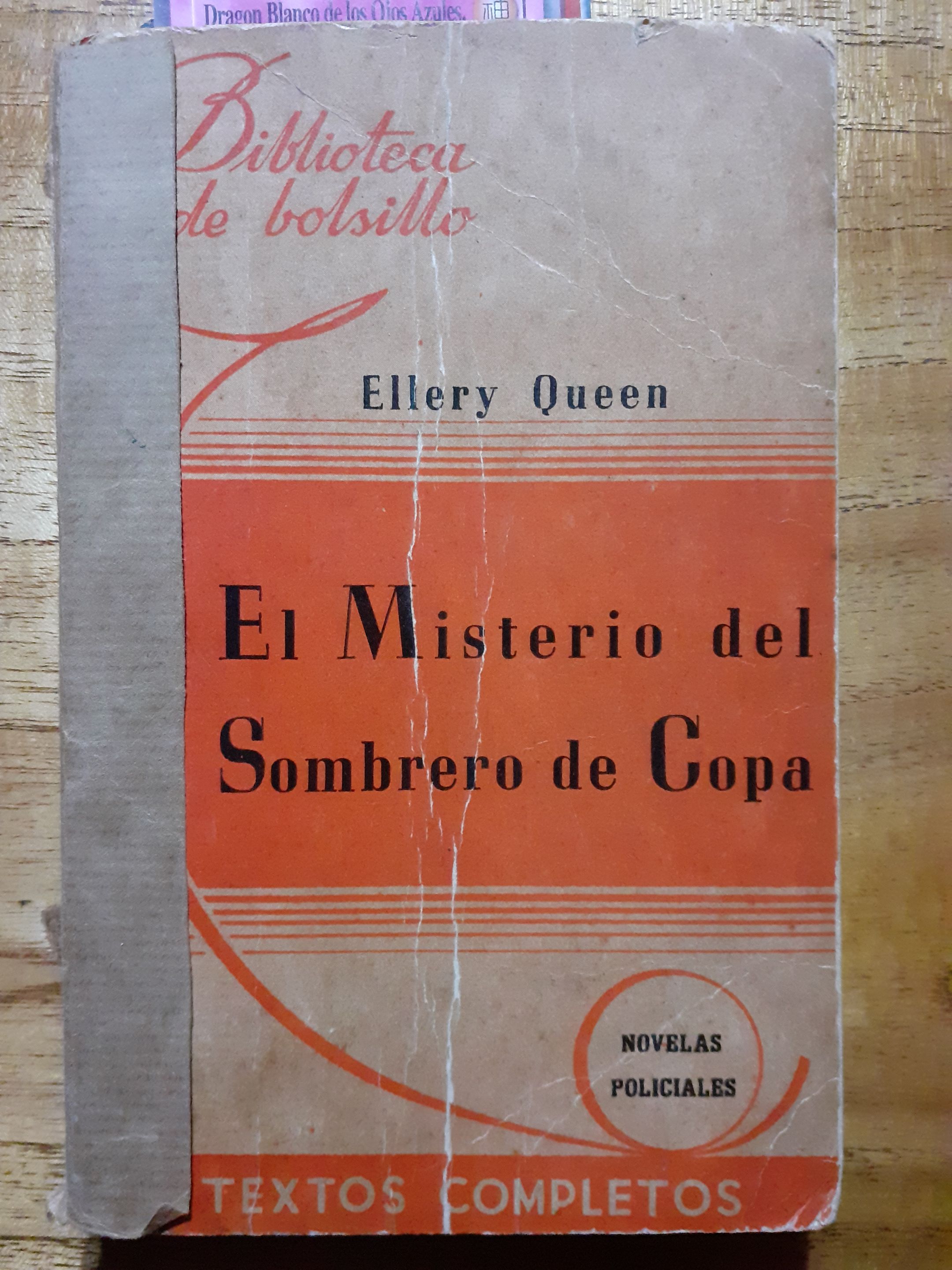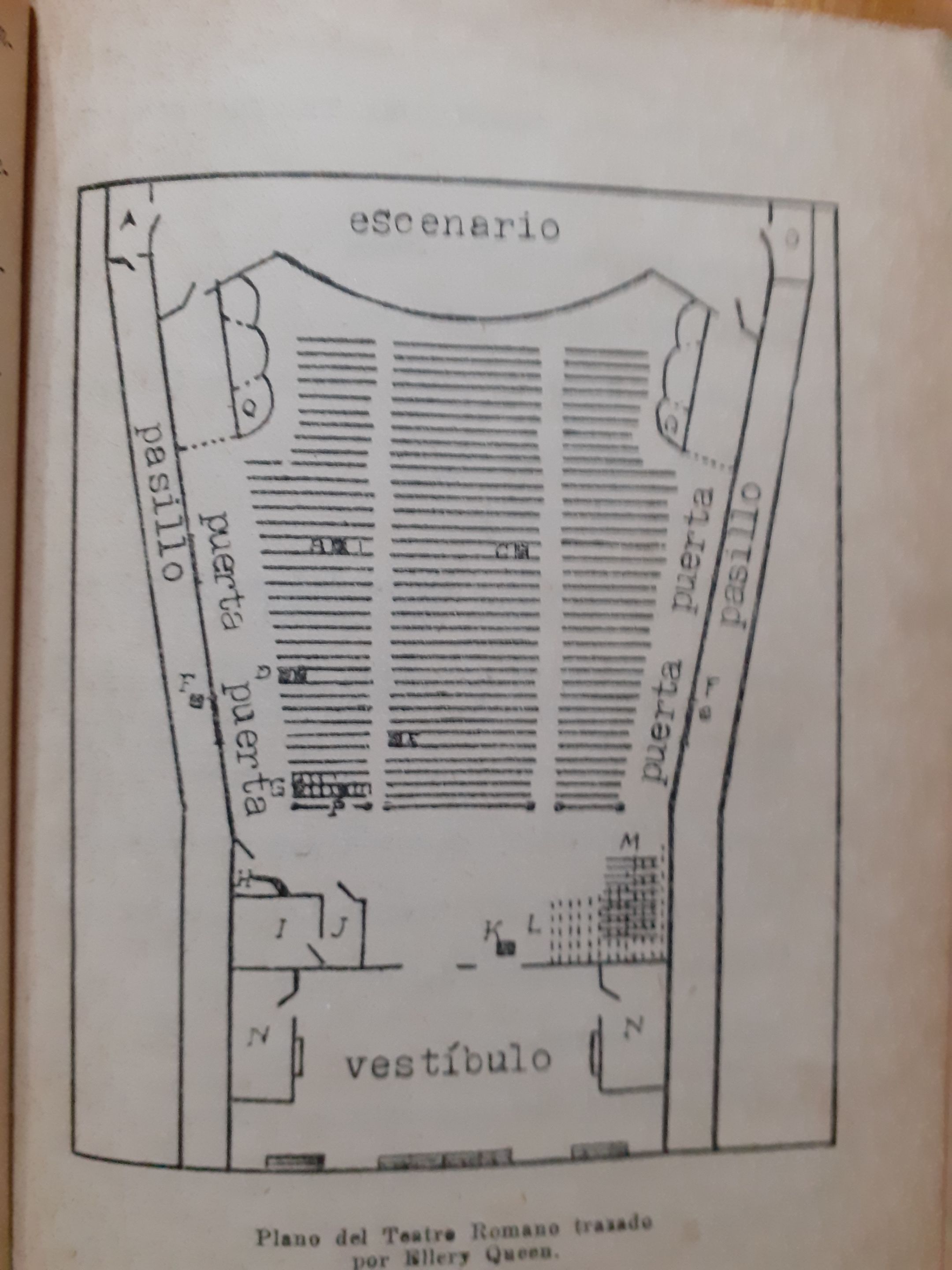El misterio del sombrero de copa
Ficha Título original: The Roman Hat Mystery Autor: Ellery Queen, seudónimo de Frederick Dannay y Manfred Bennington Lee, que eran, también, seudónimos artísticos de Daniel Nathan y Emanuel Benjamin Lepofsky. Fecha de publicación original: 1929 Editorial: Librería Hachette, 1° edición de 1943, 3° edición de 1944, Argentina, impreso en Buenos Aires. Serie Naranja de la colección Biblioteca de Bolsillo Traducción: Leonardo Defel

Este fue mi primer encuentro con Ellery Queen en todo aspecto: ni había leído antes una de sus historias ni había visto adaptación alguna de televisión o película. Lo más que sabía de él era que a Heiji Hattori de Detective Conan le gustaban más estas historias que las de Sherlock Holmes, pero tanto estas novelas como una revista de misterio con el nombre de Ellery Queen fueron muy famosas en los años 30 y 40 en Estados Unidos y aún hoy retienen popularidad entre los fans del misterio, al menos sus mejores novelas.
En Nueva York, un hombre de nombre Monte Field ha sido asesinado en uno de los asientos de un teatro, rodeado de varios asientos vacíos, cuando estaba en plena representación una obra llamada “Tiros”, aunque no fue asesinado por un tiro, sino envenenado, y sus últimas palabras fueron: “es un crimen… me han asesinado…”.
El viejo inspector Richard Queen se presenta y hace cargo del caso, y a los pocos minutos llega, tras haberlo llamado, su hijo Ellery, escritor de novelas de misterio y bibliófilo, y padre e hijo investigan juntos el asesinato de este abogado de mala reputación que le provoca a Ellery comentar que le disgusta cómo el actual sistema policial persigue implacablemente a quienes libran a la sociedad de parásitos como este abogado al que, curiosamente, le han sustraído el sombrero de copa con el que llegó al teatro.
El prefacio, escrito por un anónimo de iniciales J. J. Mc C., cuenta que este fue el penúltimo caso de Richard Queen antes de retirarse, y que Ellery halló a su futura esposa en el que fue el último caso. Además avisa que los nombres de los protagonistas, incluyendo a los Queen, son seudónimos; cuenta que el viejo Queen, el joven Queen, su esposa e hijo, viven en un pequeño pueblito de Italia, lo que recuerda al retiro de Sherlock Holmes a un pueblito tranquilo, aunque, en su caso, en solitario, y mientras esta puede ser una referencia implícita, hay otras referencias explícitas al mejor detective del mundo, en especial la de Ellery citando su famosa frase de que cuando se ha eliminado lo imposible, lo que quede, por improbable que parezca, ha de ser la respuesta. También, hay un policía listo llamado Doyle. Después del prefacio, hay una lista de personajes y un plano del lugar del crimen.

La novela sigue el procedimiento del viejo Queen interrogando testigos, inspeccionando lugares, cavilando las posibilidades. El joven Queen, con un aire menos circunspecto y serio que su padre, aunque sin llegar al desinterés, lo acompaña en sus pesquisas pero se mantiene más como observador y razonador algo apartado, dejando que su padre, quien a fin de cuentas es el agente oficial y el respetado y temido como tal, lleve la metódica iniciativa.
Comparativamente, la novela es como algo intermedio en complejidad entre las historias de Sherlock Holmes y la única que leí hasta ahora del Hércules Poirot de Agatha Christie, y también me resultó algo más corta que la de Poirot, aunque no estoy seguro de sus extensiones.
No obstante, me tomó bastante tiempo leerla porque estuve con menos tiempo para leer ficción últimamente y solía hacerlo cuando ya tenía sueño. Por otro lado, la novela se vuelve pesada de a ratos porque pasa bastante tiempo entre los descubrimientos que hacen avanzar el caso, ya que se sigue detalladamente, prácticamente sin elipsis, las pesquisas de Richard Queen, excepto cuando se ocultan algunas de sus decisiones y pensamientos para lograr un efecto sorpresa en el lector más adelante. Conan Doyle, incluso en sus cuatro novelas y ni hablar, obviamente, en sus cuentos, hace avanzar las cosas mucho más rápido poniendo resúmenes de varias actividades en boca de Watson o de Holmes.
A pesar de ese defecto de ritmo, las cosas se encaminan bien hacia la conclusión y la maniobra final para lograr la prueba de culpabilidad, y me resultó satisfactoria la resolución del misterio: quién lo hizo, por qué y cómo. También, es una buena relación de padre-hijo (el padre es viudo), de confianza y cariño mutuos.
Un curioso personaje secundario es Djuna, un huérfano de 17 años, criado o sirviente, que siente gran adoración por el viejo Queen y es amigo de Ellery. Años después, la pareja de escritores encargarían a otros la redacción de unas historias donde él es el protagonista detectivesco, pero no tiene mucha participación aquí, es más bien un relleno.
Además, antes de la resolución del misterio, Ellery Queen se dirige a los lectores directamente en una página anunciándoles que, para ese momento, ellos ya tienen todas las pistas para resolver el misterio ellos mismos. Debido a mi lectura poco seguida del libro, no intenté resolverlo porque no recordaba los suficientes hechos para intentarlo, pero veré si lo hago para la próxima historia.

Ellery Queen: The Roman Hat Mystery
This novel was published in 1929 by the cousins Frederick Dannay and Manfred Bennington Lee, pseudonyms of Daniel Nathan and Emanuel Benjamin Lepofsky. Ellery Queen's novels and a mystery magazine with that name would be very famous in America in the thirties and forties, and their best stories have retained popularity in the mystery fans.
In New York, a man named Monte Field has been murdered in one of the seats of a theater, surrounded by several empty seats, during a performance of a play titled Shots. However, he wasn’t killed by a shot, but poisoned. His last words were: “It’s a crime... I’ve been murdered…”
The old Inspector Richard Queen arrives at the scene and takes charge of the case. A few minutes later, after being called, his son Ellery arrives—he’s a mystery novelist and bibliophile—and father and son begin investigating together the murder of this disreputable lawyer, prompting Ellery to comment on how distasteful it is that the current police system relentlessly pursues those who rid society of parasites like this lawyer, whose top hat—curiously—was stolen at the theater.
The preface, written by an anonymous figure with the initials J. J. Mc C., states that this was the penultimate case of Richard Queen before retirement, and that Ellery met his future wife during what would be his last case. It also warns that the names of the protagonists, including the Queens, are pseudonyms. It says that old Queen, young Queen, his wife, and son now live in a small village in Italy—reminiscent of Sherlock Holmes’ retirement to a quiet countryside village, though Holmes retired alone. While this may be an implicit reference, there are also explicit references to the world’s greatest detective, especially when Ellery quotes his famous line that once the impossible has been eliminated, whatever remains, no matter how improbable, must be the truth. There’s also a clever policeman named Doyle.
After the preface, there is a list of characters and a diagram of the crime scene.
The novel follows old Queen’s process: questioning witnesses, inspecting locations, mulling over the possibilities. Young Queen, with a demeanor less solemn and grave than his father’s—though not indifferent—accompanies him in his investigation but remains more of an observer and slightly detached thinker, letting his father, who is after all the official agent and respected and feared as such, take the methodical lead.
This was my first encounter with Ellery Queen in every sense: I had never read one of his stories before, nor had I seen any television or film adaptation. The most I knew about him was that Heiji Hattori from Detective Conan preferred his stories to those of Sherlock Holmes.
Comparatively, the novel feels like something intermediate in complexity between Sherlock Holmes stories and the only Hercule Poirot novel I’ve read so far by Agatha Christie. It also struck me as somewhat shorter than the Poirot novel, though I’m not entirely sure about their respective lengths.
Nevertheless, it took me quite a while to read it, as I’ve had less time lately for fiction, and I usually read when I was already sleepy. On the other hand, the novel becomes a bit tedious at times because a lot of time passes between the discoveries that move the case forward, as the investigation by Richard Queen is followed in detail, almost without ellipsis—except when some of his decisions or thoughts are withheld to create a surprise effect for the reader later. Conan Doyle, even in his four novels—and of course in his short stories—moves things along much faster, using summaries of various activities delivered by Watson or Holmes.
Despite that pacing flaw, the story moves nicely toward its conclusion and the final maneuver to secure proof of guilt. I found the resolution of the mystery—who did it, why, and how—satisfying. It’s also a good depiction of a father-son relationship (the father is a widower), marked by mutual trust and affection.
A curious secondary character is Djuna, a 17-year-old orphan, ward or servant, who deeply adores old Queen and is friends with Ellery. Years later, the writing duo would commission others to write stories in which he plays the lead detective, but here he has little involvement and is more of a filler character.
Also, before the resolution of the mystery, Ellery Queen addresses the readers directly in a page where he announces that, by that point, they have all the clues they need to solve the mystery themselves. Due to my intermittent reading of the book, I didn’t try to solve it because I couldn’t remember enough details to make the attempt—but I’ll see if I can do it with the next story.
Fotos mías / My photos Versión en inglés traducida con ChatGPT /English version translated with ChatGPT